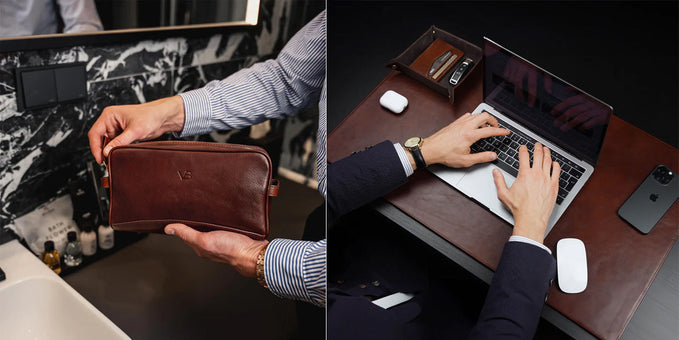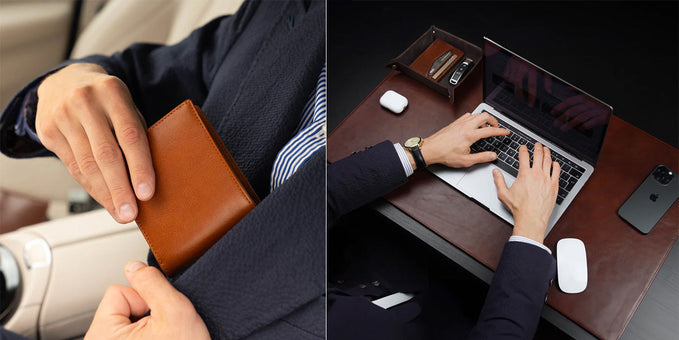Leather grades

In this post, we discuss how leather is officially graded, and how you can spot the difference between types of leather.
How Leather is Graded (And Why You Should Know)
The most common grades of leather are:
- Full-grain leather (best)
- Top-grain leather
- Split-grain leather
- Genuine leather*
- Bonded leather* (worst)
You can usually find a stamp designating a piece of real leather as top-grain, full-grain, split-grain, or genuine leather on the underside of the skin when purchasing a handbag, wallet, coat, or other leather items.
In terms of durability, wear resistance, and how the leather feels next to your skin, each grade will perform drastically differently.
If you want to purchase leather items, you’d better know a lot about them to ensure you get the most for your money.
At Von Baer, we only use full grain leather, to ensure our leather bags are the best quality possible. Learn more about us here.
Learn more about leather in our explanation video below:
*Technically, bonded and genuine leather are not leather grades. They are words that people frequently use in the leather business today. You might also come across a substance known as “corrected grain leather,” leather made smoother with the help of abrasives.
Here are more details on the process and each grade of leather:

1. Splitting the Hide
A chunk of cowhide (also known as rawhide) between 6mm and 10mm thick is put through a splitter to be divided into different pieces depending on the final usage of the leather.
For instance, split leather for upholstery will be 1.2mm thick, whereas belt leather can be 3.2 to 4mm thick.
The top of the hide, which is the most precious, and the bottom, which may be further divided to create the other grades, are separated.

2. The Top of the Hide — Full and Top-Grain Leather
The highest grade portion of the hide is used to create full-grain and top-grain leather.
Full-grain leather undergoes less processing and preserves the natural scars and imperfections as well as the complete – or full–grain hide. The more an item ages, the more beautiful the leather patina becomes because full-grain leather absorbs moisture and oil (see our video on patina here).
Contrarily, top-grain leather is dyed, buffed, and sanded to give the finished product a more uniform and refined appearance.
Top-grain leather’s natural pores have been sealed throughout the dyeing process, preventing water and oils from penetrating the leather and allowing them to be easily wiped away.
Here's a good example of a full grain leather briefcase from Von Baer:
3. The Bottom of the Hide — Genuine and Split Leather
Actually, the natural marks and grain of the hide are absent from split-grain leather. Suede, the most popular type of split-grain leather, is used to create shoes, handbags, coats, and other items where a supple and flexible material is needed.
What Does Genuine Leather Actually Mean?
Technical-wise, it is leather, but industry professionals regard it as a very low-quality product because it isn’t as solid and attractive as high-quality leather.
The excessive processing of a very fine amount of original leather means that it doesn’t really contain any of the original grain.
4. Bonded Leather
Bonded leather is a mixture of glue, leather dust, leather scraps, plastic, and vinyl, all joined together to form a new material. It’s an inexpensive leather that’s used for cheaper products, such as cheap furniture, purses, and clothing.
Compared to most genuine and bonded leather products, waxed canvas and vegan leather are more robust and of outstanding quality.

Related articles:
- Vegetable tanned leather
- Leather tanning
- What is artificial leather?
- What is full grain leather
- Where does leather come from
- Mushroom leather
- Napa leather
- Pebbled leather
How To Avoid Bad Leather Types When Purchasing
To be sure you’re getting the best leather product for your money, the next time you decide to buy leather products, look for a stamp on the underside or raw portion of the leather. If you’re unsure, give a thing the “fire test” to see whether it truly is leather. Quickly wave a lighter across the product’s broadside.
It will shrivel and burn if it’s a fake, as real leather is particularly resistant to fire.
A full-grain leather product is worth the extra money it may cost upfront because good leather can last a lifetime.
When properly maintained, a full-grain leather product can last its owner for a long time and become more attractive as it acquires the warm patina for which premium full-grain leathers are recognized.
Related leather articles:
- What is Leather
- Faux leather
- Vegan leather
- Bonded vs faux vs real leather
- Bonded leather
- Genuine leather
- Pleather
- Top grain leather
- Leather types
- What is leather patina
- How is leather made
What Leather Type Is Best for You?
If you pay close attention, you will notice that the most outstanding leather grades are full-grain and corrected-grain leather.
These two leather types will develop a patina over time because they are sheared from the same sturdy grain. Full-grain is a personal choice, but I wouldn’t have it any other way because of the flaws and personality that come with it.
Related articles:
- Suede
- PU leather
- Bonded leather vs Faux leather
- Italian leather
- How to tell if leather is real
- Buffalo leather
- Suede vs Leather
- What is Real Leather
- Pu Leather vs Faux Leather
- Alternative Leather
- Chrome Tan Leather
Conclusion
We hope you enjoyed our article on grades of leather.
If you have any questions or comments, contact us at info@vonbaer.com, or leave them in the comments.

Author: Albert Varkki
Albert Varkki is the co-founder of Von Baer. He understands leather products as a consumer, supplier, and a manufacturer, helping you with the inside knowledge you need, to choose the perfect leather product for you.
We strive for the highest editorial standards, and to only publish accurate information on our website.
Leave a Comment
Your email address will not be published.






